

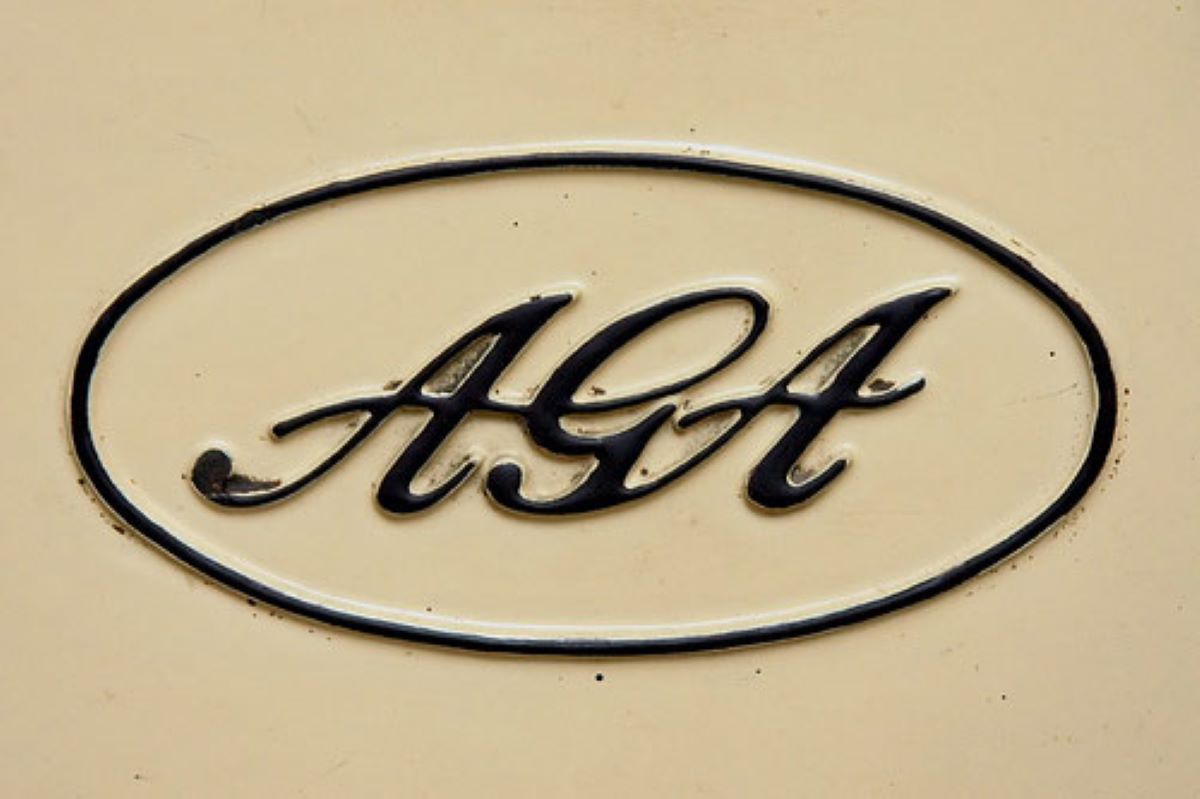
 The
purpose of this Chapter is not to give a potted History of the AGA from its
first arrival in Great Britain in 1929 until the present day. This has been
put into print on numerous occasions together with a whole family of associated
literature covering just about anything anyone could possibly want (legally)
to do with the ubiquitous cooker such as ‘How To Sell AGAs’, ‘How
to Service AGAs’, ‘How to Identify The Different AGA Models’, ‘How
to Cook In AGAs’ and ‘How to Cook On AGAs’, ‘How to
Convert AGAs’ and (probably!) ‘How to Convert you into Liking AGAs’
if you didn’t already do so! The AGA has been part of our way of life
for fractionally longer than the Anglepoise Light (helpful to see what you’re
cooking!). On arrival in Britain it was greeted by nearly three million unemployed
and faced competition from established Electric and Gas Stove manufacturers.
The
purpose of this Chapter is not to give a potted History of the AGA from its
first arrival in Great Britain in 1929 until the present day. This has been
put into print on numerous occasions together with a whole family of associated
literature covering just about anything anyone could possibly want (legally)
to do with the ubiquitous cooker such as ‘How To Sell AGAs’, ‘How
to Service AGAs’, ‘How to Identify The Different AGA Models’, ‘How
to Cook In AGAs’ and ‘How to Cook On AGAs’, ‘How to
Convert AGAs’ and (probably!) ‘How to Convert you into Liking AGAs’
if you didn’t already do so! The AGA has been part of our way of life
for fractionally longer than the Anglepoise Light (helpful to see what you’re
cooking!). On arrival in Britain it was greeted by nearly three million unemployed
and faced competition from established Electric and Gas Stove manufacturers.
Eighty two years later they have experienced something of a revival and their
adverts have seldom been absent from the glossy type of magazine - often seen
in Doctors’ and Dentists’ Surgeries!
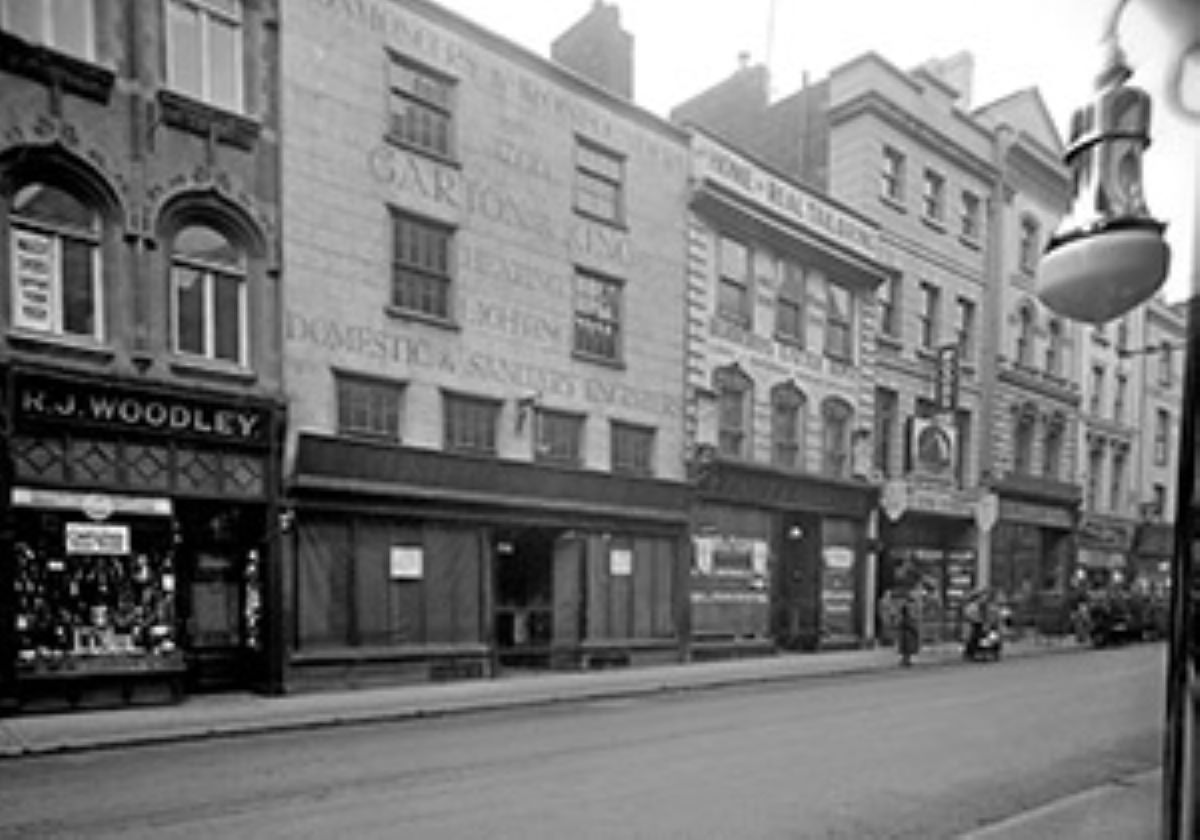 The
adjacent photograph (courtesy the ISCA Collection) dates either from 1932 or
just possibly early 1933 (click the image for a closer view). The Sale
notices that would appear not only in Garton & King’s shop but also in Pinder &
Tuckwell’s at 191 High Street have not yet been posted, and by 1934 F. W. Woolworths &
Co would be operating from this location. The posters that are displayed in
G & K’s window, actually state that AGA Demonstrations are being held and
although I cannot make out the smallest of print there are comparisons being
made in the prices of Anthracite and Coke and the conclusion that Fuel Costs
not exceeding £4 per annum could be achieved.
The
adjacent photograph (courtesy the ISCA Collection) dates either from 1932 or
just possibly early 1933 (click the image for a closer view). The Sale
notices that would appear not only in Garton & King’s shop but also in Pinder &
Tuckwell’s at 191 High Street have not yet been posted, and by 1934 F. W. Woolworths &
Co would be operating from this location. The posters that are displayed in
G & K’s window, actually state that AGA Demonstrations are being held and
although I cannot make out the smallest of print there are comparisons being
made in the prices of Anthracite and Coke and the conclusion that Fuel Costs
not exceeding £4 per annum could be achieved.
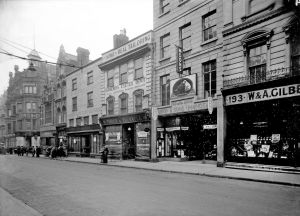 A
second view of the shop, looking in the opposite direction down High Street.
A
second view of the shop, looking in the opposite direction down High Street.
(Photo courtesy of the Isca Collection)
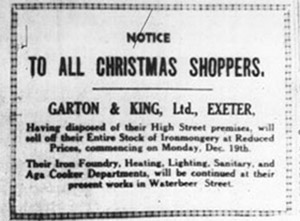 Another
indication of G & K’s AGA involvement comes in the form of an Advertisement
in Exeter’s daily paper, the Express and Echo on the 17th December 1932
and even then the purpose of the advert was to inform the public of the closure
of the large Retail Ironmongery Shop at 190 High Street, Exeter. Quite what
brought about the closure of the premises one cannot say for certain. Henry
Holladay had joined the business in 1932 but his Uncle, Hugo Holladay, retired
in 1933 and it was he that had been involved in the Ironmongery Retail Outlet
since joining the company in 1898. One thing that G & K definitely did not
do a great deal of in the 20s and 30s was advertise in newspapers - Exonians
will recognise all the ironmongers names like Munk, Wippell Bros & Rowe,
Ottons etc etc. who would regularly hawk their wares and offer varied inducements
to the public to enter their doors, G & K were most noticeable by their
absence; and this applied not only to the Express & Echo but to the Western
Times & Gazette and Street & Trade Directories. Perhaps they tended
to rest a little too much on their laurels and failed to face up to the inevitable
competition in those lean years of the depression.
Another
indication of G & K’s AGA involvement comes in the form of an Advertisement
in Exeter’s daily paper, the Express and Echo on the 17th December 1932
and even then the purpose of the advert was to inform the public of the closure
of the large Retail Ironmongery Shop at 190 High Street, Exeter. Quite what
brought about the closure of the premises one cannot say for certain. Henry
Holladay had joined the business in 1932 but his Uncle, Hugo Holladay, retired
in 1933 and it was he that had been involved in the Ironmongery Retail Outlet
since joining the company in 1898. One thing that G & K definitely did not
do a great deal of in the 20s and 30s was advertise in newspapers - Exonians
will recognise all the ironmongers names like Munk, Wippell Bros & Rowe,
Ottons etc etc. who would regularly hawk their wares and offer varied inducements
to the public to enter their doors, G & K were most noticeable by their
absence; and this applied not only to the Express & Echo but to the Western
Times & Gazette and Street & Trade Directories. Perhaps they tended
to rest a little too much on their laurels and failed to face up to the inevitable
competition in those lean years of the depression.
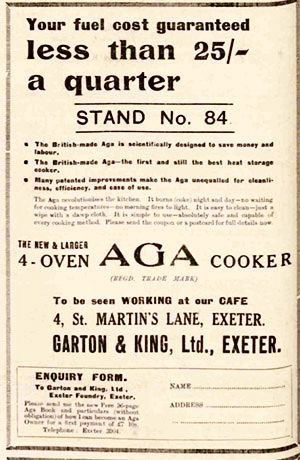 I
have reproduced Express & Echo adverts in these columns. They are not particularly
good quality and are only Photocopies. The new Foundry at Tan Lane was still
being built - it didn't come on stream until August 1939 so the first advert
(right) still refers to the Foundry as being located at Waterbeer Street. This
Advert appeared in the North Devon Journal which covered the Devon County Show;
this was held on the 22nd, 23rd & 24th of May 1935. That year the show was
held at Raleigh, Barnstaple.
I
have reproduced Express & Echo adverts in these columns. They are not particularly
good quality and are only Photocopies. The new Foundry at Tan Lane was still
being built - it didn't come on stream until August 1939 so the first advert
(right) still refers to the Foundry as being located at Waterbeer Street. This
Advert appeared in the North Devon Journal which covered the Devon County Show;
this was held on the 22nd, 23rd & 24th of May 1935. That year the show was
held at Raleigh, Barnstaple.
There is a bit of a mystery attached to the reference to 'Our Café at 4 St Martin's Lane where an AGA can be seen working' in the Advert on the right. I have never heard any mention of this, so I'd be interested if anyone knows anything about 'Our Café'.
I can now (August 2025) add to this last paragraph. Whilst I can still not find any reference to G & K owning a Café, I am able to confirm that the Café was called 'The Blue Café'. In the 1934 Besleys Guide to Exeter it lists the business at 4 (St) Martins Lane as being in the control/ownership of Miss Donnell and a Mrs Macleod. They were in business certainly in 1934 and 1935, but by 1937 the premises were occupied by Brooking & Sons, an established Exeter Jewellers.
The second advert (below) dated 1948 refers to the Central Station Showroom, which must have opened only a short while earlier. The one thing it does confirm is the connection with AGA which, having researched the matter fairly thoroughly, makes them one of the earliest AGA Agents in the UK, and this last advert seems to suggest a connection (even if not a formal agency) extending back as far as “about 1928”.
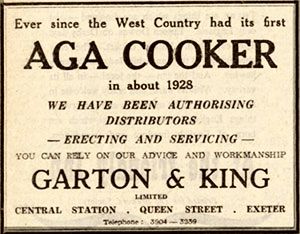
There is a tale that is often spread about that there were originally appointed just five AGA Agents - I can find nothing to substantiate this and although there are a handful of pre WW2 Agents still in business, some of which on their websites lay claim to be appointed in the very early 1930s, none of the very early ones (BLADES is an exception) have been able to provide Black & White confirmation of their believed year of appointment.
Of course, over a period of time there could have been ten or fifteen or more Agents appointed within the UK and there would naturally be the first five but this number seems to have gained a sort of Magic Status but as yet I haven’t seen the evidence. Some even suggest that Garton & King Ltd were amongst that Magic Number - I would like to be able to substantiate this but so far I can’t - what I can show is three Black & White Photos.
 The
first is 1934 - the company displayed AGAs on a stand at the Devon County Show
at Newton Abbot.
The
first is 1934 - the company displayed AGAs on a stand at the Devon County Show
at Newton Abbot.
 In
1935 we have a photograph (No 2) of the Bath & West Show at Taunton where
four of the AGA Agent fraternity jointly promoted AGAs.
In
1935 we have a photograph (No 2) of the Bath & West Show at Taunton where
four of the AGA Agent fraternity jointly promoted AGAs.
Although Spillers of Chard are still agents to this day, Hill Sawtell of Yeovil and Pople & Sons of Burnham on Sea are long gone. Garton King Appliances continue to trade at Darts Farm, Topsham and 19 North Street, Exeter.
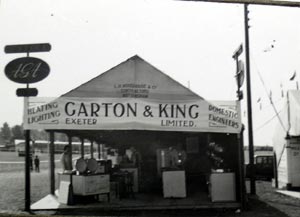 In
1936 we return to the Devon County Show, this time at Exeter in 1936 - this
is the 3rd Photo.
In
1936 we return to the Devon County Show, this time at Exeter in 1936 - this
is the 3rd Photo.
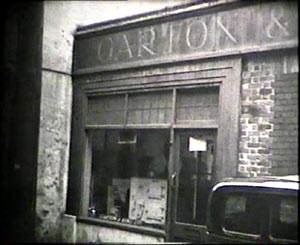 Three
more photographs, the first shows the Foundry Shop in Waterbeer Street around
1935. If you click on the picture to enlage you can see that there a two AGAs
on display through the window.
Three
more photographs, the first shows the Foundry Shop in Waterbeer Street around
1935. If you click on the picture to enlage you can see that there a two AGAs
on display through the window.
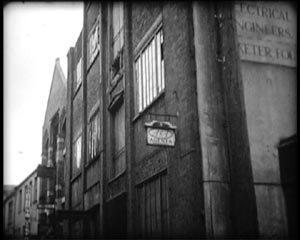 The
second shows the AGA Agency Sign on the Foundry Wall in Waterbeer Street.
The
second shows the AGA Agency Sign on the Foundry Wall in Waterbeer Street.
 The third shows the Central Station Showroom that opened in 1939, again the
Agency Sign makes a return appearance and, of course, AGAs are on display in
the showroom
The third shows the Central Station Showroom that opened in 1939, again the
Agency Sign makes a return appearance and, of course, AGAs are on display in
the showroom
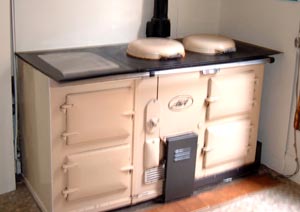 My
first personal recollection of an AGA takes me back to where I was born in Spicer
Road, Exeter. From a very early age I remember a solid fuel AGA in the kitchen
and it seems it survived new ownership and remained in situ up until 2007. In
this year the property became vacant and was put up for sale - I was fortunate
in persuading the Estate Agent to give me an opportunity to view the house and
gardens and I was amazed to find that the interior hadn’t changed all
that much with the passing of time - the colour picture (a bit fuzzy I’m
afraid) is of the AGA some sixty years or so from when I first recall it - the
only modification was that it had been converted, I believe, to operate on Mains
Gas. It may still be there.
My
first personal recollection of an AGA takes me back to where I was born in Spicer
Road, Exeter. From a very early age I remember a solid fuel AGA in the kitchen
and it seems it survived new ownership and remained in situ up until 2007. In
this year the property became vacant and was put up for sale - I was fortunate
in persuading the Estate Agent to give me an opportunity to view the house and
gardens and I was amazed to find that the interior hadn’t changed all
that much with the passing of time - the colour picture (a bit fuzzy I’m
afraid) is of the AGA some sixty years or so from when I first recall it - the
only modification was that it had been converted, I believe, to operate on Mains
Gas. It may still be there.
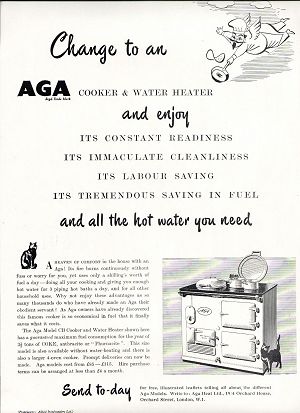 1946
saw the introduction of the AGA CB Model (CB standing for Cooker, Boiler). It
proved to be the best selling domestic model of the era. Further facts about
this model is that it was the first AGA to have a proper internal boiler that
allowed heating water in, say, a cylinder such as found in an airing cupboard.
1946
saw the introduction of the AGA CB Model (CB standing for Cooker, Boiler). It
proved to be the best selling domestic model of the era. Further facts about
this model is that it was the first AGA to have a proper internal boiler that
allowed heating water in, say, a cylinder such as found in an airing cupboard.
As a consequence of the hot water facility sales experienced a massive upturn, even though the addition of the hot water facility increased the annual fuel consumption by a ton to about three and a half tons per year. Back in the 1950s Coke, one of the three recommended fuels – the others being Anthracite and Phurnacite - was available at about £5.11.6d per ton (Imperial, not metric!) – approximately 1/- a day! (£5.50 a tonne, 5p a day).
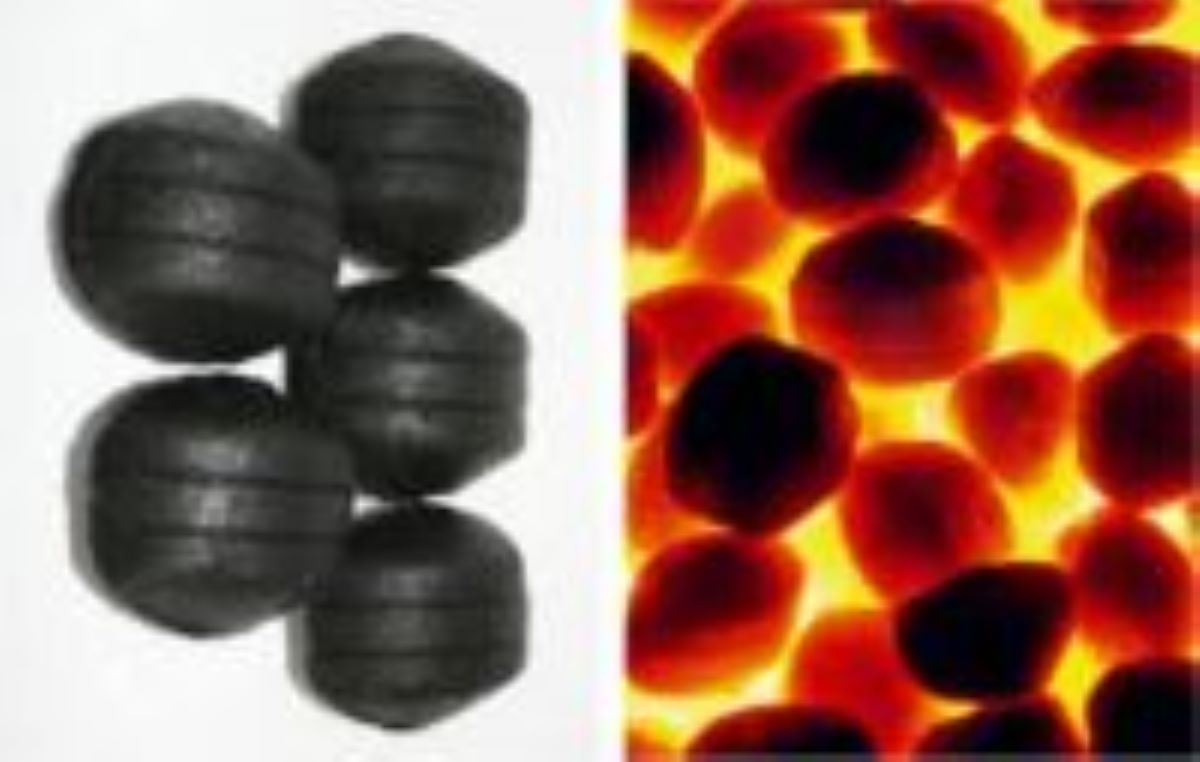
Phurnacite
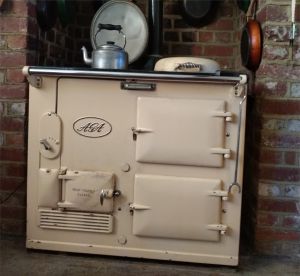 Even
nowadays there are CB AGA models happily burning solid fuel as they were designed
to do. In Cornwood in Devon a CB Model AGA which was installed in the vicarage
about 1947 and which has never left (though has been moved within the property)
still radiates its warmth in the kitchen and provides the cooking facilities
one expects from an AGA.
Even
nowadays there are CB AGA models happily burning solid fuel as they were designed
to do. In Cornwood in Devon a CB Model AGA which was installed in the vicarage
about 1947 and which has never left (though has been moved within the property)
still radiates its warmth in the kitchen and provides the cooking facilities
one expects from an AGA.
Renovated by the owner with the able assistance of Garton King Appliances
of Exeter (successors to Garton & King Ltd, see Chapter 11 of our story),
this AGA pictured here soldiers on. In the words of the current owners who,
dare I say, are the same age as the AGA! - “We will not have it converted
as long as the aptly named Mr Coker can continue to supply us with fuel!”
Whatever fuel it burns, Coke, Anthracite or Phurnacite, it is likely to cost
a tad more per ton than the 1950s price of £5.11.6d!
(December 2020)
Thanks to Richard Maggs for AGA facts.
These next four images were professionally taken on behalf of Garton & King, possibly intended for publicity purposes. The owner of the property (somewhere in Devon) was a Mr Sharland and the photos show his two daughters. The farm is still in the ownership of Mr Sharland’s family.
 |
 |
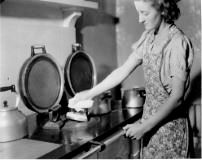 |
 |
The AGA shown here has been identified by Richard Maggs, cookery expert and AGA Historian as...
“A Standard Aga (1941-1972) Model E, which is a four-oven
non-boiler solid fuel model.
I would date this installation as being circa
1951-1953, as it has the black enamelled with chrome dome lids. For many years
after its introduction to this period they had to resort to enamelled cream
cast iron lids (found on the smaller 2-oven models) due to World War II and
post war chrome supply problems. Also the handrail brackets are not the early
type (which were enamelled cream fitted to the cream front plate) – these are
black and fitted to the black enamelled top plate.”
The two irons heating up on the AGA hotplate (third image) are flat irons, was also known as the ‘sad’ (meaning solid) iron. As the name suggests, these irons were made from solid cast iron. Flat irons were used in pairs so that whilst one was being used the other could be heated up. The two saucepans and the large 6 pint aluminium kettle are typical AGA utensils of that era.
I think the image of the cake coming out of the baking oven (second image) is a posed shot as the cake tin would definitely be too hot to handle!
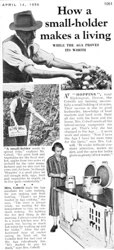
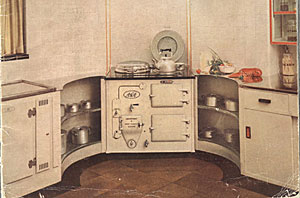 The
Advertisement (left) comes from the Country Life Magazine of 1950. “Hoppins”
is actual located at Clapham, near Shillingford to the west of Exeter. A few
enquiries and we discover the property is still known by this name and the smallholding
is much the size as described. Although the present owner knew the Colwills
and could identify the location of the AGA it has, unfortunately, long gone.
There is no evidence that Garton & King either supplied or installed the
AGA back in 1950 but there is a real possibility that they did. A Model CB AGA
Cooker back in those days would have cost around £101.10s.0d and delivery
and erection in the region of £11 plus a few quid for the flue pipes, bends
etc etc.
The
Advertisement (left) comes from the Country Life Magazine of 1950. “Hoppins”
is actual located at Clapham, near Shillingford to the west of Exeter. A few
enquiries and we discover the property is still known by this name and the smallholding
is much the size as described. Although the present owner knew the Colwills
and could identify the location of the AGA it has, unfortunately, long gone.
There is no evidence that Garton & King either supplied or installed the
AGA back in 1950 but there is a real possibility that they did. A Model CB AGA
Cooker back in those days would have cost around £101.10s.0d and delivery
and erection in the region of £11 plus a few quid for the flue pipes, bends
etc etc.
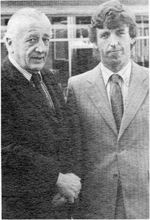 Garton
King Appliances was formed in 1973, when it was decided to separate the heating
and domestic appliance activities from the foundry side of G & K, and the
image on the right is of the two of the initial three Directors – Henry Holladay
being the third.
Garton
King Appliances was formed in 1973, when it was decided to separate the heating
and domestic appliance activities from the foundry side of G & K, and the
image on the right is of the two of the initial three Directors – Henry Holladay
being the third.
Alec Holladay is seen on the left together with his son
Michael who joined the family business in 1970.
Michael was in fact an ex AGA Heat employee and had trained as a Sales Representative at Ketley, Telford in 1961, and at the time of this image, 1979, held the post of Sales Director for AGA Cookers. The image appeared in AGA Cooker News No 10, Winter 1979 / 80 edition. Michael ceased working for the business on the retirement of his father and the sale of the business to certain employees in 1990.
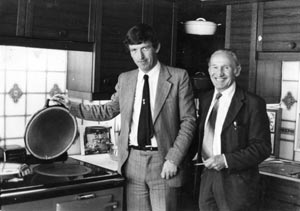 At
the time of this AGA Cooker News Article Michael’s team was six strong. Arthur
Venn was Service Manager (see below). Bill Tarr, to the right of Michael in
this image, was appointed Showroom Manager and is seen in the upstairs Showroom
of the 19 North Street premises - he joined G & K in 1946 and moved into
Sales in 1951. The rest of the team consisted of four AGA Fitters led by Derek
Pollard and Cecil Lee each of whom had at the time (1979) 25 years AGA experience
with the Company. Also at this time the Company had a fleet of Ford Transit
and Escort vehicles and were able to offer a very fast service for breakdown
and follow up calls. It was also around this period that brown, black, red,
dark blue and green coloured AGAs were introduced to the range. Pewter was top
of the popular colours in one poll in 2020, but I imagine the greater colour
choices can add to production complications & costs.
At
the time of this AGA Cooker News Article Michael’s team was six strong. Arthur
Venn was Service Manager (see below). Bill Tarr, to the right of Michael in
this image, was appointed Showroom Manager and is seen in the upstairs Showroom
of the 19 North Street premises - he joined G & K in 1946 and moved into
Sales in 1951. The rest of the team consisted of four AGA Fitters led by Derek
Pollard and Cecil Lee each of whom had at the time (1979) 25 years AGA experience
with the Company. Also at this time the Company had a fleet of Ford Transit
and Escort vehicles and were able to offer a very fast service for breakdown
and follow up calls. It was also around this period that brown, black, red,
dark blue and green coloured AGAs were introduced to the range. Pewter was top
of the popular colours in one poll in 2020, but I imagine the greater colour
choices can add to production complications & costs.
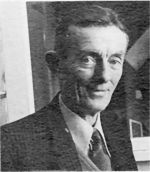 Arthur
G Venn joined Garton & King as a Clerk in 1936; his wartime service was
with the Royal Navy. He served as a navigator on one vessel that was sunk and
was one of very few from that ship’s company that survived. He returned to employment
with G & K at the end of his service and took charge of the foundry office,
managing the contracts and sales of all the products of the foundry and machine
shop. On the final closure of the foundry at Tan Lane in late 1979, he was appointed
Service Manager with Garton King Appliances.
Arthur
G Venn joined Garton & King as a Clerk in 1936; his wartime service was
with the Royal Navy. He served as a navigator on one vessel that was sunk and
was one of very few from that ship’s company that survived. He returned to employment
with G & K at the end of his service and took charge of the foundry office,
managing the contracts and sales of all the products of the foundry and machine
shop. On the final closure of the foundry at Tan Lane in late 1979, he was appointed
Service Manager with Garton King Appliances.
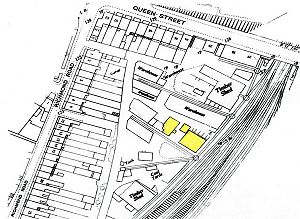
As stated above, Garton King Appliances were formed in 1973 when the
operations of the Company were split into two. However, it was not until the
closure of the Tan Lane Foundry in 1980 that it become necessary to find an
alternative base for the workshop and stores. A site was found in the former
Goods Yard near Richmond Road off Queen Street in premises once occupied by
the Devon Trading Company. The former Goods, Coal and Timber Yard served by
the railway and set out as shown on this 1975 plan drawing has changed vastly
in recent years. The premises that Garton King Appliances took are marked on
the plan in yellow.
 After the tracks in the goods yard were removed much of the area was turned
into a Car Park, some of the former buildings, however, continued to be utilised.
The archway (also seen in the third image) is pointed out here with an arrow
as is the large BT Exchange building, the Queen Street Railway Bridge and part
of the Central Station buildings. This image was taken from the entrance to
the car park on St David’s Hill.
After the tracks in the goods yard were removed much of the area was turned
into a Car Park, some of the former buildings, however, continued to be utilised.
The archway (also seen in the third image) is pointed out here with an arrow
as is the large BT Exchange building, the Queen Street Railway Bridge and part
of the Central Station buildings. This image was taken from the entrance to
the car park on St David’s Hill.
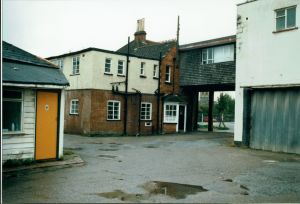 A
close up of the premises occupied by Garton King Appliances. The ‘bridge’ and
the building to the right were not part of the property the company rented..
A
close up of the premises occupied by Garton King Appliances. The ‘bridge’ and
the building to the right were not part of the property the company rented..
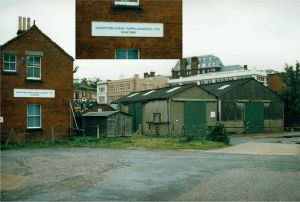 It
is obvious from the signage on the left hand building in this last image -
click to enlarge - that the brick building was used by Garton King
Appliances, additionally the two large sheds to the right were also used by
them. When the buy-out of GKA took place in May 1990 the new management continued
to operate the business from this location in addition to 19 North St. Eventually,
in about October 2004, a new facility opened at Darts Farm near Topsham and
the company moved out of these premises. Nowadays (2021) the site is totally
unrecognisable as all that can be seen now are many new housing blocks where
these premises and the car park once were.
It
is obvious from the signage on the left hand building in this last image -
click to enlarge - that the brick building was used by Garton King
Appliances, additionally the two large sheds to the right were also used by
them. When the buy-out of GKA took place in May 1990 the new management continued
to operate the business from this location in addition to 19 North St. Eventually,
in about October 2004, a new facility opened at Darts Farm near Topsham and
the company moved out of these premises. Nowadays (2021) the site is totally
unrecognisable as all that can be seen now are many new housing blocks where
these premises and the car park once were.
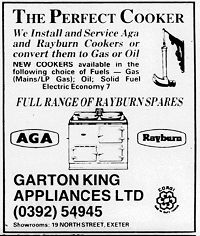 This,
by my reckoning (and having performed some lengthy searching) is probably the
last advert ever placed by Garton King Appliances whilst still in the Holladay
Family ownership. It was published in the Herald Express, a Torquay based newspaper,
on the 11th April 1990, some 22 days before the company was bought out by a
group of employees, its new owners P. Regan, H. Meldon & D. Aldridge.
This,
by my reckoning (and having performed some lengthy searching) is probably the
last advert ever placed by Garton King Appliances whilst still in the Holladay
Family ownership. It was published in the Herald Express, a Torquay based newspaper,
on the 11th April 1990, some 22 days before the company was bought out by a
group of employees, its new owners P. Regan, H. Meldon & D. Aldridge.
The business that now trades as GARTON KING APPLIANCES Ltd is the result
of the buy-out in May 1990. From 1990 the Holladay family ceased to have any
financial involvement with the business. The 19 North Street premises survived
as Showroom and Offices up until June 2023. The business continues to trade
from the Darts Farm, Topsham location and with the closure of North Street,
after an occupancy of some 65 years, the offices have relocated to the units
they occupy at 2 Fair Oak Court near to Exeter Airport. The Company continues
to trade under the sign of The Golden Hammer and maintains the Company’s long
association with AGA Cookers.
The original Golden Hammer is currently loaned
to the Royal Albert Memorial Museum by the Holladay family (see the
Golden Hammer page).
On Thursday 13th July 2023 the sale of 19 North Street was completed and the current owners of Garton King Appliances moved out and effectively and finally severed the trading link that the company and its forbears had established with Exeter’s City Centre; a period of some 362 years, 65 years of which has been at 19 North Street. Alas, the end of an era.
Well, that’s about it for this Chapter - once again any comments or criticisms or contributions (photos, memorabilia and the like) are always welcome - I am always on the lookout for early AGA Advertising Material, or Cookbooks - particularly pre-war and wartime.
More about the history of Aga can be found here.
Updated July 2023
Top of page
See also:
Flying the Flag —
Workplaces
Waterbeer Street Foundry —
High Street
Cooking Equipment —
Golden Hammer Sign
Sitemap
/ Contents